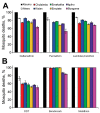Pyrethroid and DDT Resistance and Organophosphate Susceptibility among Anopheles spp. Mosquitoes, Western Kenya
- PMID: 26583525
- PMCID: PMC4672417
- DOI: 10.3201/eid2112.150814
Pyrethroid and DDT Resistance and Organophosphate Susceptibility among Anopheles spp. Mosquitoes, Western Kenya
Abstract
We conducted standard insecticide susceptibility testing across western Kenya and found that the Anopheles gambiae mosquito has acquired high resistance to pyrethroids and DDT, patchy resistance to carbamates, but no resistance to organophosphates. Use of non-pyrethroid-based vector control tools may be preferable for malaria prevention in this region.
Keywords: Africa; Anopheles; DDT; Kenya; arabiensis; carbamate; gambiae; insecticide resistance; malaria; mosquitoes; organophosphate; pyrethroid; sensu lato; sensu stricto; susceptibility; vector-borne infections.
Figures


Similar articles
-
Chlorfenapyr: a pyrrole insecticide for the control of pyrethroid or DDT resistant Anopheles gambiae (Diptera: Culicidae) mosquitoes.Acta Trop. 2007 Apr;102(1):69-78. doi: 10.1016/j.actatropica.2007.03.003. Epub 2007 Mar 12. Acta Trop. 2007. PMID: 17466253
-
Characterizing the insecticide resistance of Anopheles gambiae in Mali.Malar J. 2015 Aug 22;14:327. doi: 10.1186/s12936-015-0847-4. Malar J. 2015. PMID: 26296644 Free PMC article.
-
Multimodal pyrethroid resistance in malaria vectors, Anopheles gambiae s.s., Anopheles arabiensis, and Anopheles funestus s.s. in western Kenya.PLoS One. 2011;6(8):e22574. doi: 10.1371/journal.pone.0022574. Epub 2011 Aug 11. PLoS One. 2011. PMID: 21853038 Free PMC article.
-
Can anything be done to maintain the effectiveness of pyrethroid-impregnated bednets against malaria vectors?Philos Trans R Soc Lond B Biol Sci. 1998 Oct 29;353(1376):1769-75. doi: 10.1098/rstb.1998.0329. Philos Trans R Soc Lond B Biol Sci. 1998. PMID: 10021774 Free PMC article. Review.
-
Insecticide resistance in Anopheles mosquitoes : additional obstacles in the battle against malaria.Med Sante Trop. 2016 Nov 1;26(4):423-431. doi: 10.1684/mst.2016.0634. Med Sante Trop. 2016. PMID: 28073732 Review. English.
Cited by
-
Bionomics and distribution of malaria vectors in Kisumu city, Western Kenya: Implications for urban malaria transmission.Res Sq [Preprint]. 2024 Sep 19:rs.3.rs-4943539. doi: 10.21203/rs.3.rs-4943539/v1. Res Sq. 2024. PMID: 39372941 Free PMC article. Preprint.
-
Relationship between insecticide resistance profiles in Anopheles gambiae sensu lato and agricultural practices in Côte d'Ivoire.Parasit Vectors. 2023 Aug 9;16(1):270. doi: 10.1186/s13071-023-05876-0. Parasit Vectors. 2023. PMID: 37559080 Free PMC article.
-
A comparison of the attractiveness of flowering plant blossoms versus attractive targeted sugar baits (ATSBs) in western Kenya.PLoS One. 2023 Jun 6;18(6):e0286679. doi: 10.1371/journal.pone.0286679. eCollection 2023. PLoS One. 2023. PMID: 37279239 Free PMC article.
-
Insecticide susceptibility status in two medically important mosquito vectors, Anopheles gambiae, and Culex quinquefasciatus to three insecticides commonly used in Niger State, Nigeria.Saudi J Biol Sci. 2023 Feb;30(2):103524. doi: 10.1016/j.sjbs.2022.103524. Epub 2022 Dec 27. Saudi J Biol Sci. 2023. PMID: 36660609 Free PMC article.
-
Residual efficacy of SumiShield™ 50WG for indoor residual spraying in Ethiopia.Malar J. 2022 Dec 2;21(1):364. doi: 10.1186/s12936-022-04395-0. Malar J. 2022. PMID: 36461066 Free PMC article. Clinical Trial.
References
-
- World Health Organization. World Malaria Report 2013. Geneva: WHO; 2013. [cited 2015 Aug 8]. http://www.who.int/malaria/publications/world_malaria_report_2013/en/
-
- Ngufor C, Chouaïbou M, Tchicaya E, Loukou B, Kesse N, N'Guessan R, et al. Combining organophosphate-treated wall linings and long-lasting insecticidal nets fails to provide additional control over long-lasting insecticidal nets alone against multiple insecticide-resistant Anopheles gambiae in Côte d’Ivoire: an experimental hut trial. Malar J. 2014;13:396. 10.1186/1475-2875-13-396 - DOI - PMC - PubMed
Publication types
MeSH terms
Substances
Grants and funding
LinkOut - more resources
Full Text Sources
Other Literature Sources
Miscellaneous

